STIHL FS 110 Owner's Manual
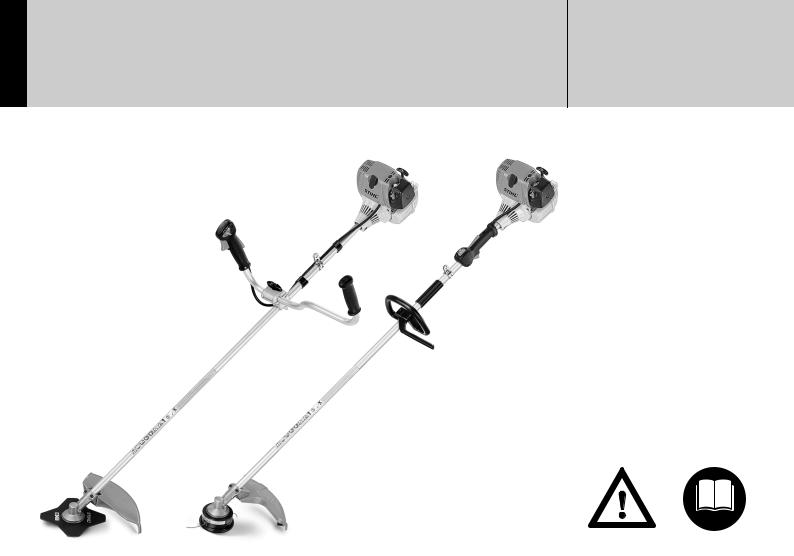
{
STIHL FS 110
Instruction Manual
Manual de instrucciones
Warning!
Read and follow all safety precautions in Instruction Manual – improper use can cause serious or fatal injury.
Advertencia!
Lea y siga todas las precauciones de seguridad dadas en el manual de instrucciones – el uso incorrecto puede causar lesiones graves o mortales.
Instruction Manual 1 - 54
Manual de instrucciones 55 - 112
Contents
|
Guide to Using this Manual |
2 |
Specifications |
|
Safety Precautions and Working |
|
Special Accessories |
Manual |
Techniques |
3 |
Maintenance and Repairs |
Approved Combinations of Cutting |
|
STIHL Incorporated Federal |
|
Attachment, Deflector, Handle and |
|
Emission Control Warranty |
|
Instruction |
Harness |
18 |
Statement |
Approved Power Tool Attachments |
20 |
STIHL Incorporated California |
|
Original |
Mounting the Bike Handle |
20 |
Exhaust and Evaporative |
Mounting the Loop Handle |
22 |
Emissions Control Warranty |
|
|
Adjusting the Throttle Cable |
24 |
Statement |
recycled.be |
Fitting the Carrying Ring |
24 |
Trademarks |
Mounting the Cutting Attachment |
25 |
|
|
|
Mounting the Deflector |
24 |
|
can |
4-MIX Engine |
28 |
|
paper |
|
||
Fuel |
29 |
|
|
oils, |
Fueling |
30 |
|
free-chlorineonpaper vegetablecontaininks |
Fitting the Harness |
31 |
|
Balancing the Trimmer/Brushcutter |
32 |
|
|
|
|
||
|
Starting / Stopping the Engine |
33 |
|
|
Operating Instructions |
36 |
|
Printed Printing |
Cleaning the Air Filter |
36 |
|
Engine Management |
36 |
|
|
|
|
||
|
Adjusting the Carburetor |
37 |
|
|
Spark Arresting Screen in Muffler |
38 |
|
|
Spark Plug |
39 |
|
2011 |
Lubricating the Gearbox |
40 |
|
Replacing the Starter Rope and |
|
|
|
STIHLANDREAS© AG & Co. KG, 8621-254-0458-C. M11.H11.CP. 0070000000384GB |
|
|
|
Rewind Spring |
40 |
|
|
{ |
42 |
|
|
|
Storing the Machine |
|
|
|
Sharpening Metal Cutting Blades |
43 |
|
|
Maintenance and Care |
44 |
|
|
Main Parts |
46 |
|
English
48 |
Allowonlypersonswhofullyunderstand |
49 |
this manual to operate your trimmer / |
brushcutter. |
|
49 |
To receive maximum performance and |
|
satisfaction from your STIHL trimmer / |
50 |
brushcutter,itisimportantthatyouread, |
|
understand and follow the safety |
|
precautions and the operating and |
|
maintenance instructions in chapter |
52 |
"Safety Precautions and Working |
Techniques"beforeusingyourtrimmer/ |
54brushcutter. For further information you can go to www.stihlusa.com.
Contactyour STIHLdealer or theSTIHL distributor for your area if you do not understandanyoftheinstructionsinthis manual.
 Warning!
Warning!
Because a trimmer / brushcutter is a high-speed cutting tool some special safety precautions must be observed to reduce the risk of personal injury. Care- lessorimproperusemaycauseserious or even fatal injury.
Makesureyourunitisequippedwiththe properdeflector,handleandharnessfor the type of cutting attachment being used. Always wear proper eye protection.
FS 110, FS 110 R |
1 |
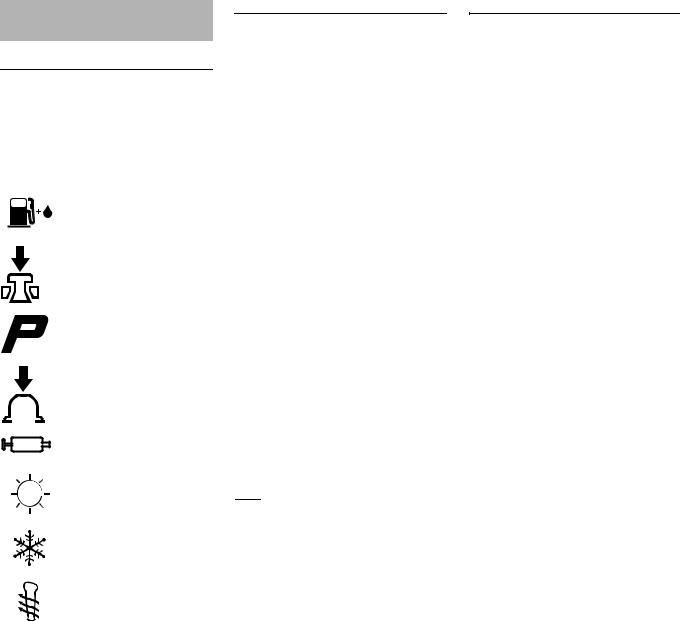
English
Guide to Using this Manual
Pictograms
The meanings of the pictograms attached to or embossed on the machine are explained in this manual.
Dependingonthemodelconcerned,the following pictograms may be on your machine.
Fuel tank for gasoline and engine oil mixture
Press to operate decom- pression valve
Manual fuel pump
Press to operate manual fuel pump
Filler hole for gear lubricant
Air intake summer mode
Air intake winter mode
Handle heating
Symbols in Text
Many operating and safety instructions are supported by illustrations.
The individual steps or procedures describedin themanualmaybemarked in different ways:
N A bullet marks a step or procedure.
A description of a step or procedure that refers directly to an illustration may contain item numbers that appear in the illustration. Example:
N Loosen the screw (1). N Lever (2) ...
In addition to the operating instructions, this manual may contain paragraphs that require your special attention. Such paragraphs are marked with the symbols and signal words described below:
 Danger!
Danger!
Indicates an imminent risk of severe or fatal injury.
 Warning!
Warning!
Indicatesahazardoussituationwhich,if not avoided, could result in severe or fatal injury.
 Caution!
Caution!
Indicates a risk of property damage, including damage to the machine or its individual components.
Engineering Improvements
STIHL’s philosophy is to continually improve all of its products. As a result, engineeringchangesandimprovements are made from time to time. Therefore, some changes, modifications and improvements may not be covered in this manual. If the operating characteristics or the appearance of your machine differs from those describedinthismanual,pleasecontact your STIHL dealer for assistance.
2 |
FS 110, FS 110 R |

Safety Precautions and
Working Techniques
Because a trimmer / brushcutter is a highspeed, fast-cutting power tool sometimes equipped with sharp cutting blades, special safety precau- tions must be observed to reduce the risk of per- sonal injury.
It is important that you read, fully understand and observe the following safety precautions and warnings. Read the instruction manual and the safety precautions periodically. Careless or improper use may cause serious or fatal injury.
The terminology utilized in this manual when referring to the power tool reflects the fact that different types of cutting attachments may be mounted on it. The term "trimmer" is used to designate an FS unit thatisequippedwith anylonline head or a head with flexible plastic blades (i.e., the PolyCut head). A "brushcutter" designates a unit equipped with a rigid metal blade. Many FS models may be used as either a trimmer or a brushcutter – therefore, the powertoolisreferredinthismanualasa "trimmer / brushcutter." Some smaller and / or lightweight FS models may only be used as a trimmer, i.e., they may not be used with metal blades.
The term "clearing saw" indicates a high-powered trimmer / brushcutter that is particularly suited for use with a circular saw blade to clear saplings or small trees.
FSmodelswithan"R"onthenameplate were originally configured (at the time of distribution) as a trimmer with a loop handle.
 Warning!
Warning!
As more fully explained later in these SafetyPrecautions,toreducetheriskof personal injury, make sure your unit is equipped with the proper handle, har- nessanddeflectorforthetypeofcutting attachment you are using. Use only cut- ting attachments that are specifically authorized by STIHL for use on your FS model.
Have your STIHL dealer show you how to operate your power tool. Observe all applicable local safety regulations, standards and ordinances.
 Warning!
Warning!
Do not lend or rent your power tool with- out the instruction manual. Be sure that anyone using it understands the infor- mation contained in this manual.
English
 Warning!
Warning!
The use of this machine may be hazard- ous.Iftherotatinglineorbladecomesin contact with your body, it will cut you.
When it comes in contact with solid for- eign objects such as rocks or bits of metal, it may fling them directly or by ric- ochet in the direction of bystanders or theoperator.Strikingsuchobjectscould damagethecuttingattachmentandmay cause blades to crack, chip or break. Thrownobjects,includingbrokenheads or blades, may result in serious or fatal injury to the operator or bystanders. STIHL does not recommend the use of rigid blades when cutting in stony areas.
Useyourtrimmer/brushcutterequipped with the appropriate cutting attachment only for cutting grass, brush, wood and similar material.
 Warning!
Warning!
Do not use it for other purposes, since misuse may result in personal injury or property damage, including damage to the machine.
 Warning!
Warning!
Minors should never be allowed to use this power tool. Bystanders, especially children, and animals should not be allowed in the area where it is in use.
FS 110, FS 110 R |
3 |

English
 Warning!
Warning!
To reduce the risk of injury to bystand- ers and damage to property, never let yourpowertoolrununattended.Whenit is not in use (e.g. during a work break), shut it off and make sure that unauthor- ized persons do not use it.
Most of these safety precautions and warnings apply to the use of all STIHL trimmers / brushcutters. Different models may have different parts and controls. See the appropriate section of yourinstruction manual for adescription of the controls and the function of the parts of your model.
Safe use of a trimmer / brushcutter involves
1.the operator
2.the power tool
3.the use of the power tool.
THE OPERATOR
Physical Condition
You must be in good physical condition and mental health and not under the influence of any substance (drugs, alcohol, etc.) which might impair vision, dexterity or judgment. Do not operate this machine when you are fatigued.
 Warning!
Warning!
Be alert – if you get tired, take a break. Tiredness may result in loss of control. Working with any power tool can be strenuous. If you have any condition that might be aggravated by strenuous work, check with your doctor before operating this machine.
 Warning!
Warning!
Prolonged use of a power tool (or other machines) exposing the operator to vibrations may produce whitefinger dis- ease (Raynaud's phenomenon) or carpal tunnel syndrome.
These conditions reduce the hand's ability to feel and regulate temperature, produce numbness and burning sensations and may cause nerve and circulation damage and tissue necrosis.
All factors which contribute to whitefinger disease are not known, but cold weather, smoking and diseases or physical conditions that affect blood vessels and blood transport, as well as high vibration levels and long periods of
exposure to vibration are mentioned as factorsinthedevelopmentofwhitefinger disease. In order to reduce the risk of whitefinger disease and carpal tunnel syndrome, please note the following:
–Most STIHL power tools are available with an anti-vibration ("AV") system designed to reduce the transmission of vibrations created by the machine to the operator's hands. An AV system is recommended for those persons using power tools on a regular or sustained basis.
–Wear gloves and keep your hands warm.
–Keep the AV system well maintained. A power tool with loose components or with damaged or worn AV elements will tend to have higher vibration levels.
–Maintain a firm grip at all times, but do not squeeze the handles with constant, excessive pressure. Take frequent breaks.
All the above-mentioned precautions do not guarantee that you will not sustain whitefinger disease or carpal tunnel syndrome. Therefore, continual and regular users should closely monitor the condition of their hands and fingers. If any of the above symptoms appear, seek medical advice immediately.
4 |
FS 110, FS 110 R |
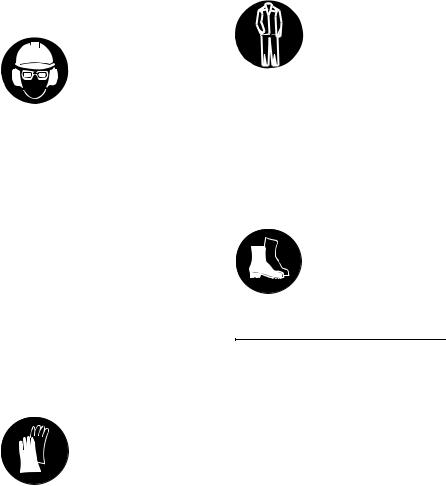
 Warning!
Warning!
The ignition system of the STIHL unit produces an electromagnetic field of a very low intensity. This field may inter- fere with some pacemakers. To reduce theriskofseriousorfatalinjury,persons with a pacemaker should consult their physician and the pacemaker manufac- turer before operating this tool.
Proper Clothing
To reduce the risk of injury, the operator should wear proper protective apparel.
 Warning!
Warning!
The deflector provided with your power tool will not protect the operator from all foreignobjects(gravel,glass,wire,etc.) thrown back by the rotating cutting attachment. Thrown objects may also ricochet and strike the operator.
 Warning!
Warning!
To reduce the risk of injury to your eyes never operate your power tool unless wearing goggles
or properly fitted protec- tive glasses with
adequate top and side protection com- plying with ANSI Z 87.1 (or your applicable national standard). To reduce the risk of injury to your face STIHL recommends that you also wear a face shield or face screen over your goggles or protective glasses.
Wear an approved safety hard hat to reduce the risk of injury to your head when there is a danger of head injuries.
Power tool noise may damage your hearing.Wearsoundbarriers(earplugs or ear mufflers) to protect your hearing. Continual and regular users should have their hearing checked regularly.
Be particularly alert and cautious when wearing hearing protection because your ability to hear warnings (shouts, alarms, etc.) is restricted.
Always wear gloves when handling the machine and metal blades. Heavy-duty, non- slip gloves improve your grip and help to protect your hands.
English
Clothing must be sturdy and snug-fitting, but allow
complete freedom of movement. Wear long pants made of heavy material to help protect your legs. Do not wear shorts, sandals or go
barefoot.
Avoid loose-fitting jackets, scarfs, neckties, jewelry, flared or cuffed pants, unconfined long hair or anything that could become caught on branches, brush or the moving parts of the unit. Secure hair so it is above shoulder level.
Good footing is very important. Wear sturdy boots with nonslip soles. Steel-toed safety boots are recommended.
THE POWER TOOL
For illustrations and definitions of the power tool parts see the chapter on "Main Parts."
FS 110, FS 110 R |
5 |
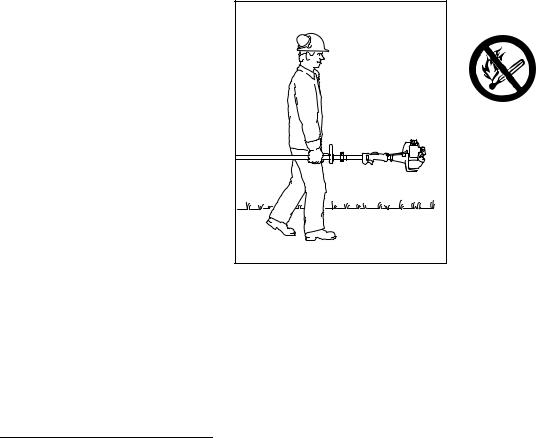
English
 Warning!
Warning!
Nevermodifythispowertoolinanyway. Only attachments supplied by STIHL and expressly approved by STIHL for use with the specific STIHL model are authorized. Although certain unauthor- ized attachments are useable with STIHL power tools, their use may, in fact, be extremely dangerous. For the cutting attachments authorized by STIHL for your unit, see the chapter "Approved Combinations of Cutting Attachment, Deflector, Handle and Har- ness" in the instruction manual or the STIHL "Cutting Attachments, Parts & Accessories" catalog.
If this tool is subjected to unusually high loads for which it was not designed (e.g. heavy impact or a fall), always check that it is in good condition before continuingwork.Checkinparticularthat the fuel system is tight (no leaks) and that the controls and safety devices are working properly. Do not continue operating this machine if it is damaged. Incaseofdoubt,haveitcheckedbyyour STIHL servicing dealer.
THE USE OF THE POWER TOOL
Transporting the Power Tool
 Warning!
Warning!
To reduce the risk of injury from loss of control and blade or line contact, never carry or transport your power tool with the cutting attachment moving.
389BA019 KN |
It may be carried only in a horizontal position. Grip the shaft in a manner that the machine is balanced horizontally. Keep the hot muffler away from your body and the cutting attachment behind you.
 Warning!
Warning!
Always shut off the engine and make surethecuttingattachmenthasstopped before putting a trimmer / brushcutter down. When transporting it in a vehicle, properly secure it to prevent turnover, fuel spillage and damage to the unit.
STIHL recommends that you keep metal blades covered with the transport guard (optional accessory).
Fuel
Your STIHL power tool uses an oilgasoline mixture for fuel (see the chapter on "Fuel" of your instruction manual).
 Warning!
Warning!
Gasoline is an extremely flammable fuel. If spilled and ignited by a spark or other ignition source, it can cause fire and seri-
ous burn injury or property damage. Use extreme caution when handling gasoline or fuel mix. Do notsmokeorbringanyfireorflamenear the fuel or the power tool. Note that combustible fuel vapor may escape from the fuel system.
Fueling Instructions
 Warning!
Warning!
To reduce the risk of serious injury from burns, never attempt to refuel the unit until it has been completely removed from the operator.
 Warning!
Warning!
Fuel your power tool in well-ventilated areas, outdoors. Always shut off the engine and allow it to cool before refu- eling. Gasoline vapor pressure may build up inside the fuel tank depending onthefuelused,theweatherconditions and the tank venting system.
In order to reduce the risk of burns and other personal injury from escaping gas vapor and fumes, remove the fuel filler cap onyour power toolcarefullysoas to allow any pressure build-up in the tank toreleaseslowly. Never remove thefuel filler cap while the engine is running.
6 |
FS 110, FS 110 R |
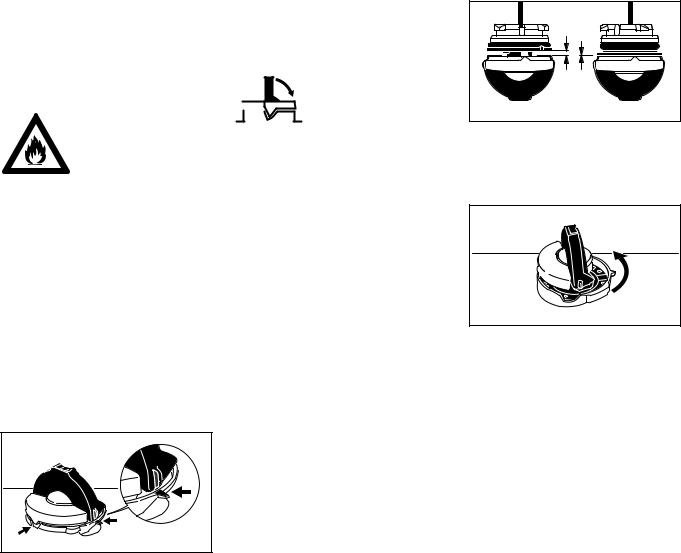
Selectbare groundforfuelingandmove at least 10 feet (3 m) from the fueling spot before starting the engine. Wipe off any spilled fuel before starting your machine.
 Warning!
Warning!
Check for fuel leakage while refueling and dur- ing operation. If fuel leakage is found, do not start or run the engine untiltheleakisfixedand
any spilled fuel has been wiped away. Take care not to get fuel on your cloth- ing. If this happens, change your clothing immediately.
Different models may be equipped with different fuel caps.
Toolless cap with grip
 Warning!
Warning!
In order to reduce the risk of fuel spill- age and fire from an improperly tightened fuel cap, correctly position and tighten the fuel cap in the fuel tank opening.
001BA220 KN
To do this with this STIHL cap, raise the griponthetopofthecapuntilitisupright at a 90° angle. Insert the cap in the fuel tank opening with the raised positioning
FS 110, FS 110 R
marks on the grip of the cap and on the fuel tank opening lining up. Using the grip, press the cap down firmly while turning it clockwise as far as it will go (approx. 1/4 turn).
Fold the grip flush with the top of the cap. Grip 



 the cap and check for tightness. If the grip does not lie completely flush
the cap and check for tightness. If the grip does not lie completely flush
with the cap and the detent on the grip does not fit in the correspond- ing recess in the filler opening, or if the cap is loose in the filler opening, the cap is not properly seated and tightened and you must repeat the above steps.
Misaligned, damaged or broken cap
NIfthecapdoesnotdropfullyintothe openingwhenthepositioningmarks line up and/or if the cap does not tighten properly when twisted, the baseofthecapmaybeprematurely rotated (vis-à-vis the top) to the closed position. Such misalignment can result from handling, cleaning or an improper attempt at tightening.
English |
001BA227 KN |
Left: |
Base of cap in closed posi- |
|
tion (with open space) |
Right: |
Base of cap correctly posi- |
|
tioned for installation |
001BA226 KN |
NTo return the cap to the open position for installation, turn the cap (with the grip up) until it drops fully intothetankopening.Next,twistthe capcounterclockwiseasfarasitwill go (approx. 1/4 turn) – this will twist the base of the cap into the correct position. Then, twist the cap clockwise, closing it normally.
NIf your cap still does not tighten properly, it may be damaged or broken; immediately stop use of the unit and take it to your authorized STIHL dealer for repair.
7

English
Screw Cap
 Warning!
Warning!
Unit vibrations can cause an improperly tightened fuel filler cap to loosen or
come off and spill quanti- ties of fuel. In order to reduce the risk of fuel
spillage and fire, tighten the fuel filler cap by hand as securely as possible.
See also the "Fueling" chapter in your Instruction Manual for additional information.
Before Starting
 Warning!
Warning!
Alwayscheckyourpowertoolforproper condition and operation before starting, particularly the throttle trigger, throttle trigger lockout, slide control / stop switch, cutting attachment, deflector and harness. The throttle trigger must move freely and always spring back to the idle position. Never attempt to mod- ify the controls or safety devices.
 Warning!
Warning!
Never operate your power tool if it is damaged, improperly adjusted or main- tained, or not completely or securely assembled.
 Warning!
Warning!
Do not attach any cutting attachment to a unit without proper installation of all requiredparts.Failure to usethe proper partsmaycausethebladeorheadtofly off and seriously injure the operator or bystanders.
 Warning!
Warning!
The cutting attachment must be prop- erly tightened and in safe operating condition. Inspect for loose parts (nuts, screws, etc.) and for cracked or dam- agedheadsorcracked,bent,warpedor damaged blades. Replace damaged heads or blades before using the power tool. Always keep blades sharp.
Keep the handles clean and dry at all times; it is particularly important to keep themfreeofmoisture,pitch,oil,fuelmix, grease or resin in order for you to maintain a firm grip and properly control your power tool.
 Warning!
Warning!
Check that the spark plug boot is securely mounted on the spark plug – a loose boot may cause arcing that could ignite combustible fumes and cause a fire.
 Warning!
Warning!
To reduce the risk of personal injury to the operator
from blade or line contact and
thrown objects, make sure your unit is equipped with the proper deflector, han- dle and harness for the type of cutting attachment being used (see chart in the chapter on "Approved Combinations of Cutting Attachment, Deflector, Handle and Harness").
As can be seen in that chart, some cutting attachments may require you to change your deflector, handle and / or harness.
Keep the deflector (and the attached skirt where appropriate) adjusted properly at all times (see chapters on "Mounting the Deflector" and "Mounting the Cutting Attachment" of your instruction manual).
8 |
FS 110, FS 110 R |
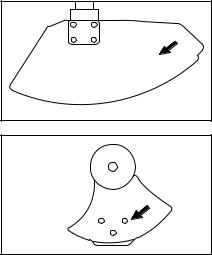
A
000BA006 KN
B
000BA007 KN
Arrows on the deflector (A) and limit stop (B) (as seen from the underside) show the correct direction of rotation of the cutting attachment. When viewed from above, however, the cutting attachment rotates counterclockwise.
Adjustcarryingharnessandhandgripto suit your size before starting work. The machineshouldbeproperlybalancedas specified in your instruction manual for proper control and less fatigue in operation.Tobebetterpreparedincase of an emergency, practice releasing the unit from the harness as quickly as possible.
Starting
Start the engine at least 10 feet (3 m) from the fueling spot, outdoors only.
Forspecificstartinginstructions,seethe appropriate section of your manual. Place the power tool on firm ground or
other solid surface in an open area. Maintain good balance and secure footing.
 Warning!
Warning!
Toreducetheriskofinjuryfrombladeor line contact, be absolutely sure that the cuttingattachmentisclearofyouandall other obstructions and objects, includ- ing the ground, because when the engine starts at starting-throttle, engine speed will be fast enough for the clutch to engage and move the cutting attachment.
Once the engine has started, immediately blip the throttle trigger, whichshouldreleasethestartingthrottle and allow the engine to slow down to idle.
With the engine running only at idle, attach the power tool to the spring hook of your harness (see appropriate chapter of this manual).
 Warning!
Warning!
Your power tool is a one-person machine. Do not allow other persons in the general work area, even when starting.
 Warning!
Warning!
To reduce the risk of injury from loss of control, do not attempt to "drop start" your power tool.
English
 Warning!
Warning!
When you pull the starter grip, do not wrap thestarterropearound yourhand. Do not let the grip snap back, but guide the starter rope to rewind it properly.
Failure to follow this procedure may result in injury to your hand or fingers and may damage the starter mechanism.
Important Adjustments
 Warning!
Warning!
To reduce the risk of personal injury from loss of control or contact with the running cutting attachment, do not use your unit with incorrect idle adjustment. At correct idle speed, the cutting attach- mentshouldnotmove.Fordirectionson how to adjust idle speed, see the appro- priate section of your instruction manual.
If you cannot set the correct idle speed, have your STIHL dealer check your power tool and make proper adjustments and repairs.
FS 110, FS 110 R |
9 |
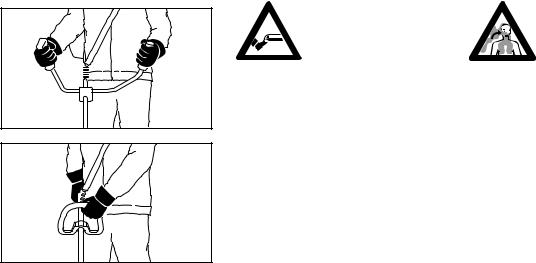
English
During Operation
Holding and Controlling the Power Tool
002BA055 KN
002BA054 KN
Always hold the unit firmly with both hands on the handles while you are working. Wrap your fingers and thumbs around the handles, keeping the handles cradled between your thumb and forefinger. Keep your hands in this position to have your power tool under control at all times. Make sure your trimmer handles and grips are in good condition and free of moisture, pitch, oil, fuel mix or grease.
 Warning!
Warning!
Never attempt to operate your power tool with one hand. Loss of control of
thepowertoolresultingin seriousorfatalinjurymay result. To reduce the risk
of cut injuries, keep hands and feet away from the cutting attachment. Never touch a moving cutting attach- mentwithyour handor anyotherpart of your body.
 Warning!
Warning!
Do not overreach. Keep proper footing and balance at all times. Special care must be taken in slippery conditions (wet ground, snow) and in difficult, over- grown terrain. Watch for hidden obstacles such as tree stumps, roots and ditches to avoid stumbling. For bet- ter footing, clear away scrub and cuttings. Be extremely cautious when working on slopes or uneven ground.
 Warning!
Warning!
To reduce the risk of injury from loss of control, never work on a ladder or on any other insecure support. Never hold the cutting attachment above waist height.
Working Conditions
Operate and start your power tool only outdoors in a well ventilated area. Operate it under good visibility and daylight conditions only. Work carefully.
 Warning!
Warning!
As soon as the engine is running, this product gen- erates toxic exhaust
 fumes containing chemi- cals, such as unburned hydrocarbons (including benzene) and carbon monoxide, that
fumes containing chemi- cals, such as unburned hydrocarbons (including benzene) and carbon monoxide, that
are known to cause respiratory prob- lems, cancer, birth defects, or other reproductive harm. Some of the gases (e.g. carbon monoxide) may be color- less and odorless. To reduce the risk of serious or fatal injury / illness from inhal- ing toxic fumes, never run the machine indoors or in poorly ventilated locations.
 Warning!
Warning!
If the vegetation being cut or the sur- rounding ground is coated with a chemical substance (such as an active pesticide or herbicide), read and follow the instructions and warnings that accompanied the substance at issue.
10 |
FS 110, FS 110 R |
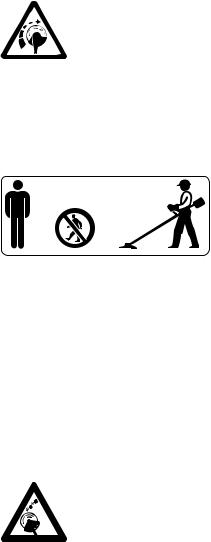
 Warning!
Warning!
Inhalation of certain dusts, especially organic dusts such as mold or pollen, can cause susceptible persons to have an allergic or asthmatic reaction. Sub- stantial or repeated inhalation of dust andotherairbornecontaminants,inpar- ticularthose withasmallerparticlesize, may cause respiratory or other ill- nesses. Control dust at the source where possible. Use good work prac- tices, such as operating the unit so that the wind or operating process directs any dust raised by the power tool away from the operator. Follow the recom- mendations of EPA / OSHA / NIOSH and occupational and trade associa- tions with respect to dust ("particulate matter"). When the inhalation of dust cannot be substantially controlled, i.e., kept at or near the ambient (back- ground) level, the operator and any bystanders should wear a respirator approvedbyNIOSH/MSHAforthetype of dust encountered.
Operating Instructions
 Warning!
Warning!
Do not operate your power tool using the starting throttle lock, as you do not have control of the engine speed.
In the event of an emergency, shut off the engineimmediately– movetheslide control / stop switch to 0 or STOP.
 Warning!
Warning!
The cutting attachment continues to rotate for a short period after the throttletriggerisreleased (flywheel effect).
 Warning!
Warning!
The rotating cutting attachment may fling foreign objects directly or by rico- chet a great distance.
 15m (50ft)
15m (50ft)
Toreducetheriskofeyeandotherinjury always wear proper eye protection (see the chapter on "Proper Clothing") and ensure that bystanders are at least 50 feet (15 m) away. To reduce the risk ofdamagetoproperty,alsomaintainthis distance from such objects as vehicles orwindows.Anycoworkerswhomustbe in the restricted area should also wear goggles or protective glasses. Stop the engine immediately if you are approached.
 Warning!
Warning!
Before you start work, examine the area for stones,glass,fencewire, metal,trashorothersolid objects. The cutting attachment could throw objects of this kind.
English
 Warning!
Warning!
This trimmer / brushcutter is normally to be used at ground level with the cutting attachment parallel to the ground. Use of a trimmer / brushcutter above ground level or with the cutting attachment per- pendicular to the ground may increase the risk of injury, since the cutting attachment is more fully exposed and the power tool may be more difficult to control. Never use your trimmer / brush- cutter as a hedge trimmer.
 Warning!
Warning!
During cutting, check the tightness and the condition of the cutting attachment atregularshortintervalswiththeengine andattachmentstopped.Ifthebehavior of the attachment changes during use, stop the engine immediately, wait until thecuttingattachmentstops,andcheck the nut securing the attachment for tightness and the blade or head for cracks, wear and damage.
FS 110, FS 110 R |
11 |

English
 Warning!
Warning!
A loose blade or head may vibrate, crack, break or come off the trimmer / brushcutter,whichmayresultinserious orfatalinjury.Makesurethatthecutting attachment is properly tightened. Use the wrench supplied or one of sufficient length to obtain the proper torque. If the blade or head loosens after being prop- erly tightened, stop work immediately. The retaining nut may be worn or dam- aged and should be replaced. If the blade or head continues to loosen, see yourSTIHLdealer.Neveruseatrimmer / brushcutter with a loose cutting attachment.
 Warning!
Warning!
Replace a cracked, damaged or wornout head or a cracked, bent, warped, damaged, dull or worn out blade imme- diately, even if damage is limited to superficial cracks. Such attachments may shatter at high speed and cause serious or fatal injury.
 Warning!
Warning!
When using rigid blades, avoid cutting close to fences, sides of buildings, tree trunks,stonesorothersuchobjectsthat couldcausethepowertooltokickoutor could cause damage to the blade.
STIHL recommends use of the nylon line heads for such jobs. In addition, be alert to an increased possibility of rico- chets in such situations.
 Warning!
Warning!
If the head, blade or deflector becomes clogged or stuck, always shut off the engine and make sure the cutting attachment has stopped before clean- ing. Grass, weeds, etc. should be cleanedoffthebladeorfromaroundthe head at regular intervals.
 Warning!
Warning!
To reduce the risk of unintentional rota- tionofthecuttingattachmentandinjury, always shut off the engine and remove thesparkplugbootbefore replacingthe cuttingattachment.Toreducetheriskof injury,alwaysshutofftheenginebefore adjusting the length of the nylon line on manually adjustable mowing heads.
 Warning!
Warning!
The gearbox becomes hot during oper- ation. To reduce the risk of burn injury, do not touch the gear housing when it is hot.
 Warning!
Warning!
The muffler and other parts of the engine (e.g. fins of the cylinder, spark plug) become hot during operation and remain hot for a while after stopping the engine. To reduce risk of burns do not touch the muffler and other parts while they are hot.
 Warning!
Warning!
Toreducetheriskoffireandburninjury, keep the area around the muffler clean. Remove excess lubricant and all debris such as pine needles, branches or leaves. Let the engine cool down sitting onconcrete,metal,baregroundorsolid wood away from any combustible substances.
 Warning!
Warning!
Never modify your muffler. The muffler could be damaged and cause an increase in heat radiation or sparks, thereby increasing the risk of fire and burn injury. You may also permanently damage the engine. Have your muffler serviced and repaired by your STIHL servicing dealer only.
Catalytic Converter
 Warning!
Warning!
Some STIHL power tools are equipped with a cata- lytic converter, which is
designed to reduce the exhaust emissions of the engine by a chemical
process in the muffler. Due to this proc- ess, the muffler does not cool down as rapidly as conventional mufflers when the engine returns to idle or is shut off. To reduce the risk of fire and burn inju- ries, the following specific safety precautions must be observed.
12 |
FS 110, FS 110 R |
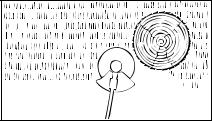
 Warning!
Warning!
Sinceamufflerwithacatalyticconverter cools down less rapidly than conven- tional mufflers, always set your power tool down in the upright position and never locate it where the muffler is near dry brush, grass, wood chips or other combustible materials while it is still hot.
 Warning!
Warning!
An improperlymounted ordamagedcyl- inder housing or a damaged / deformed muffler shell may interfere with the cool- ing process of the catalytic converter. To reduce the risk of fire or burn injury, donotcontinueworkwithadamagedor improperlymountedcylinder housingor a damaged / deformed muffler shell.
Yourcatalyticconverterisfurnishedwith screens designed to reduce the risk of fire from the emission of hot particles. Due to the heat from the catalytic reaction, these screens will normally stay clean and need no service or maintenance. If you experience loss of performanceandyoususpectaclogged screen,haveyourmufflermaintainedby a STIHL servicing dealer.
USING THE CUTTING ATTACHMENT
For an illustration of the various cutting attachments and instructions on proper mounting see the chapter on "Mounting the Cutting Attachment" in your instruction manual.
 Warning!
Warning!
To reduce the risk of severe or fatal injuryfromblade contactand/orloss of control, never attempt to use a metal blade on an FS model for which it is not authorized.
Using the Mowing Heads
Do not use with mowing line longer than the intended length. With a properly mounted deflector, the built-in linelimiting blade will automatically adjust the line to its proper length.
Using the unit with an overly long nylon cutting line increases the load on the engineandreducesitsoperatingspeed. This causes the clutch to slip continuously and results in overheating and damage to important components (e.g. clutch, polymer housing components). Such damage could, among other things, cause the cutting attachment to rotate at idle.








 002BA354 KN
002BA354 KN
Mowing heads are to be used only on trimmers / brushcutters equipped with a line-limiting blade in the deflector in order to keep the line at the proper length (see "Main Parts" chapter in your instruction manual).
English
If the lawn edges are planted with trees or bordered by a fence etc., it is best to use a nylon line head. It achieves a "softer" cut with less risk of damaging tree bark etc. than polymer blades.
However, the polymer-bladed STIHL PolyCut produces a better cut if there arenoplantsalongtheedgeofthelawn. Sharpening is not necessary, and worn polymer blades are easily replaced.
 Warning!
Warning!
To reduce the risk of serious injury, never use wire or metal-reinforced line or other material in place of the nylon cutting lines. Pieces of wire could break off and be thrown at high speed toward the operator or bystanders.
STIHL SuperCut mowing head
Fresh line is advanced automatically. Frayed line is replaced by a simple adjustment (see instruction sheet supplied with mowing head).
STIHL AutoCut mowing head
Nylon cutting line advances automatically when tapped against the ground (TapAction).
STIHL TrimCut mowing head
Frayed line is replaced by a simple adjustment (see instruction sheet supplied with mowing head).
STIHL PolyCut mowing head
Uses either nylon lines or nonrigid, pivoting polymer blades.
Observe wear indicators.
FS 110, FS 110 R |
13 |
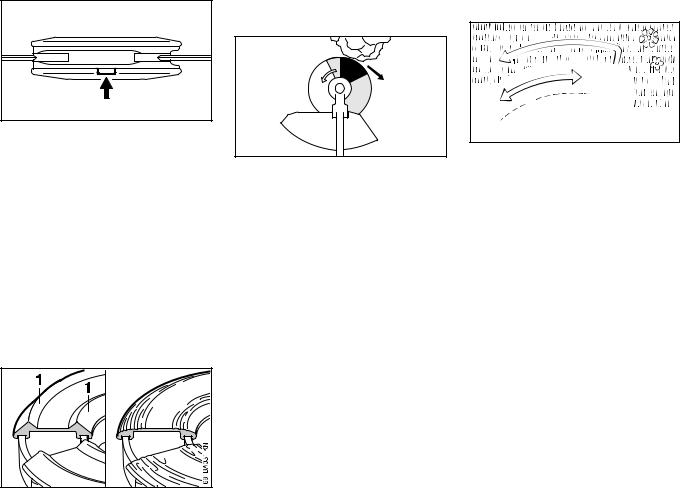
English |
002BA177 KN |
 Warning!
Warning!
Three rectangular wear limit marks are applied to the base (periphery) of the PolyCut. To reduce the risk of serious injury from breakage of the head or blades, the PolyCut must not be used when it has worn as far as one of these marks. It is important to follow the main- tenance instructions supplied with the head.
STIHL FixCut mowing head Uses pre-cut lengths of nylon line. Observe wear indicators.
Do not continue using the mowing head if the raised moldings (1) on the base are missing or worn – see right illustration above. The mowing head mayotherwiseshatterandflyingobjects could result in injury to the operator or bystanders. Install a new mowing head.
Risk of Kickout (Blade Thrust) with all Rigid Cutting Blades
002BA135 KN
 Warning!
Warning!
Kickout(bladethrust)isthesudden and uncontrolled motion towards the opera- tor's right or rear that can occur when the shaded area (especially the darkly shaded area) of a rotating blade comes in contact with a solid rigid object like a tree, rock, bush or wall. The rapid coun- terclockwise rotation of the blade may be stopped or slowed, and the cutting attachmentmaybethrowntotherightor to the rear.
This kickout (blade thrust) may cause lossofcontrolofthepowertoolandmay result in serious or fatal injury to the operator or bystanders. To reduce the risk of injury, extreme caution should be used when cutting with the shaded area of any rigid blade.
Using the Grass Cutting Blade














 002BA355 KN
002BA355 KN
All kinds of grass and weeds can be easily cut with the grass cutting blade. The power tool is swept in an arc similar to a scythe.
 Warning!
Warning!
To reduce the risk of serious or fatal injury from blade breakage, never attempt to use this blade to cut woody materials.
The 4-tooth grass cutting blade is intended to cut grass and weeds. It has 4 cutting knives with cutting edges on both sides, i.e. front and rear. When the cutting edges on one side become dull, the blade can be turned over to utilize the cutting edges on the other side.
The 8-tooth grass cutting blade is recommended for cutting fern or reed.
Bothtypesofgrasscuttingbladehaveto be resharpened when all cutting edges are dull.
Using the Brush Knife
When fitted to the power tool, the brush knife is suitable for applications ranging from cutting matted grass to clearing weeds, wild growth and scrub.
14 |
FS 110, FS 110 R |
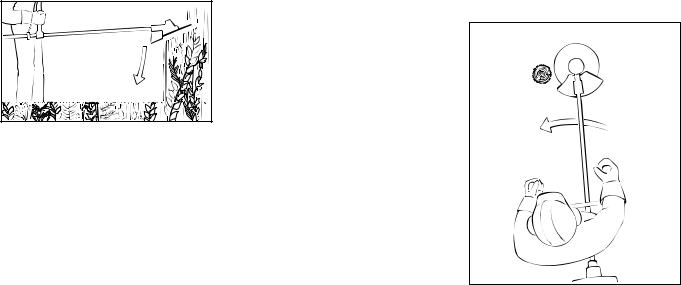
002BA066 KN |
To cut wild growth and scrub, lower the rotating brush knife down onto the growth to achieve a chopping effect – but keep the tool below waist height at all times.
 Warning!
Warning!
Exercise extreme caution when using this method of cutting. The higher the cutting attachment is off the ground, the greater the risk of loss of control and of cuttings being thrown sideways.
Use the power tool like a scythe to cut grass, i.e. sweep it to and fro in an arc.
 Warning!
Warning!
When cutting woody materials, use the left side of the blade to avoid "kickout" (blade thrust) situations.
 Warning!
Warning!
Improper use of a brush knife may cause it to crack, chip or shatter. Thrown blade fragments may seriously or fatally injure the operator or bystand- ers. To reduce the risk of injury, avoid contactwithhardorsolidforeignobjects such as stones, rocks or pieces of metal.
FS 110, FS 110 R
 Warning!
Warning!
When cutting young saplings or other woody materials up to 2 cm (3/4 in.) in diameter, use the left side of the blade toavoid"kickout"situations(seesection on"Riskofkickout(bladethrust)withall rigid cutting blades"). Do not attempt to cut woody material with a larger diame- ter,sincetheblademaycatchorjerkthe power tool forward. This may cause damage to the blade or power tool or loss of control of the power tool, result- inginpersonalinjury.Useacircularsaw blade for such work.
 Warning!
Warning!
Inspect the brush knife at regular short intervals for signs of damage. Do not continueworkingwithadamagedbrush knife. Resharpen the brush knife regu- larly (when it has dulled noticeably).
English
Using the Circular Saw Blade
000BA016 KN
Circular saw blades are suitable for thinningbrushandcuttingsmalltreesup to a diameter of 4 cm (1 1/2 in.). Do not attempt to cut trees with larger diameters, since the blade may catch or jerk the trimmer / brushcutter forward. This may cause damage to the blade or loss of control of the power tool and result in serious injury. Use a chain saw for such work.
 Warning!
Warning!
To reduce the risk that the blade will crack and / or break, avoid all contact with stones, rocks or the ground.
Sharpen blades in a timely manner as specified – dull teeth may cause the blade to crack or shatter.
When a trimmer / brushcutter with a circular saw blade is used to cut down smalltrees,STIHLrecommendsthatthe
15
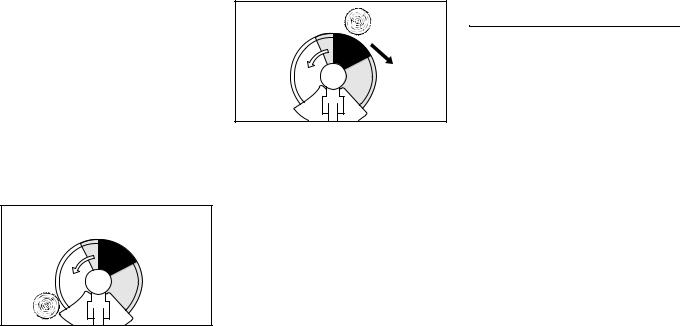
English
standard deflector be removed and replaced by the special limit stop deflector (see chapter on "Mounting the Deflector"). This limit stop helps to keep the unit positioned against the tree during the cutting process. Inexperienced users should place the leftsideofthestopagainstthetreetrunk before beginning to cut. This will keep thetrimmer/brushcutteragainstthetree during the cutting operation and will reduce the risk of loss of control and possible kickout (described above and briefly again below).
002BA214 ST
Before starting the cut, accelerate the engine up to full throttle. Perform cut with uniform pressure. STIHL recommends that the circular saw blade be applied to the right of the tree, using the non-shaded area of the blade, as shown in the illustration above.
002BA068 KN
 Warning!
Warning!
The risk of kickout is highest when cut- ting in the darker shaded area. To reduce the risk of kickout and resulting injury,donotusethisareaofthecircular saw blade for cutting trees or shrubs. Special techniques using the lighter shaded areas of the blade to cut shrubs and trees should only be used by expe- rienced operators with specialized training in the use and control of the trimmer / brushcutter.
 Warning!
Warning!
To reduce the risk of loss of control and serious injury to the operator or bystanders by akickout, never use a cir- cular saw blade on a trimmer / brushcutter with a loop handle, but rather only on one with a bicycle handle.
When felling small trees, maintain a distanceofatleasttwotreelengthsfrom the nearest coworker.
 Warning!
Warning!
In order to reduce the risk of injury from thrown objects or operator contact with the blade or head, be sure to remount the standard deflector when no longer using a circular saw blade.
MAINTENANCE, REPAIR AND STORING
Maintenance, replacement, or repair of the emission control devices and systems may be performed by any nonroad engine repair establishment or individual. However, if you make a warranty claim for a component which has not been serviced or maintained properly or if nonapproved replacement parts were used, STIHL may deny coverage.
 Warning!
Warning!
Use only identical STIHL replacement partsformaintenanceandrepair.Useof non-STIHL parts may cause serious or fatal injury.
Strictly follow the maintenance and repair instructions in the appropriate sections of your instruction manual.
 Warning!
Warning!
Always stop the engine and make sure that the cutting attachment is stopped before doing any maintenance or repair work or cleaning the power tool. Do not attemptanymaintenanceorrepairwork not described in your instruction man- ual. Have such work performed by your STIHL servicing dealer only.
Wear gloves when handling or performing maintenance on blades.
16 |
FS 110, FS 110 R |
 Warning!
Warning!
Use the specified spark plug, and make sure it and the ignition lead are always clean and in good condition. Always press the spark plug boot snugly onto the spark plug terminal of the proper size. (Note: If the terminal has a detach- able SAE adapter nut, it must be securely attached.) A loose connection between the spark plug and the ignition wire connector in the boot may create arcing that could ignite combustible fumes and cause a fire.
 Warning!
Warning!
Never test the ignition system with the sparkplugbootremovedfromthespark plugorwitharemovedsparkplug,since uncontained sparking may cause a fire.
 Warning!
Warning!
Do not operate your power tool if the muffler is damaged, missing or modi- fied. An improperly maintained muffler will increase the risk of fire and hearing loss.Ifyourmufflerwasequippedwitha spark-arresting screen to reduce the risk of fire, never operate your power toolifthescreenismissingordamaged. Remember that the risk of forest fires is greater in hot or dry weather.
 Warning!
Warning!
Never repair damaged cutting attach- ments by welding, straightening or modifying the shape. This may cause parts of the cutting attachment to come off and result in serious or fatal injuries.
English
Keep blades sharp. Tighten all nuts, bolts and screws, except the carburetor adjustment screws, after each use.
Do not clean your machine with a pressure washer. The solid jet of water may damage parts of the machine.
Store the power tool in a dry and high or locked location out of reach of children.
Before storing for longer than a few days, always empty the fuel tank. See chapter "Storing the Machine" in the instruction manual.
FS 110, FS 110 R |
17 |
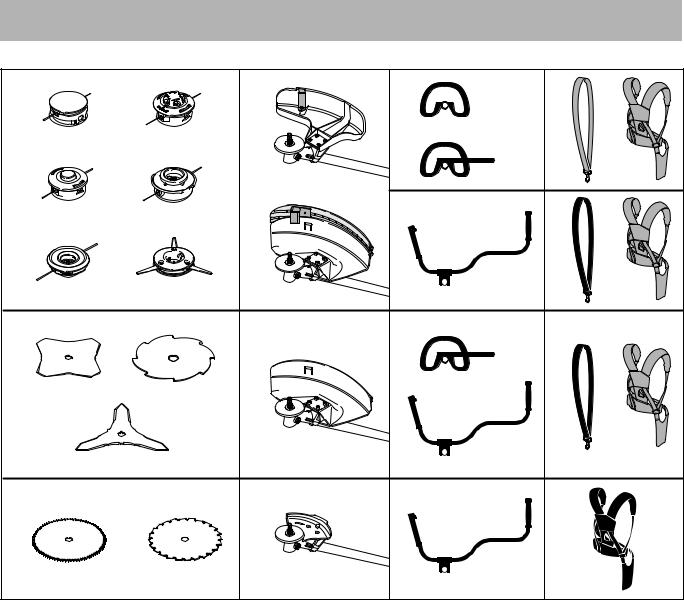
English
Approved Combinations of Cutting Attachment, Deflector, Handle and Harness
Cutting attachment |
|
Deflector |
Handle |
|
Harness |
|
1 |
2 |
12 |
17 |
|
21 |
23 |
|
|
|
|
|
||
3 |
4 |
|
18 |
|
19 |
|
|
14 |
|
|
|
||
|
|
|
|
|
|
|
5 |
6 |
13 |
|
20 |
22 |
23 |
|
|
|||||
|
|
|
|
|||
7 |
8 |
15 |
18 |
|
19 |
|
|
|
|
|
22 |
23 |
|
|
|
|
|
|
||
9 |
|
|
|
|
|
|
|
|
16 |
|
|
|
|
10 |
11 |
|
|
|
|
24 |
|
|
|
|
|
|
249BA064 KN |
18 |
|
|
|
|
|
FS 110, FS 110 R |
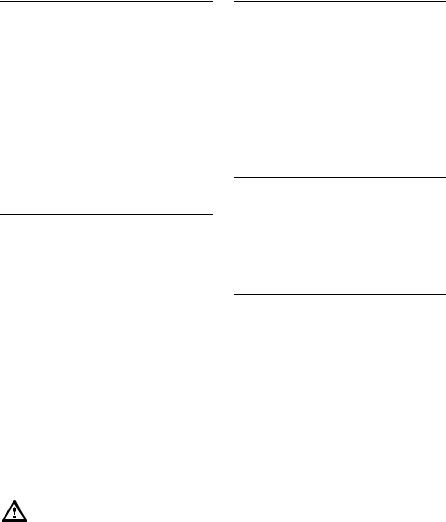
Permissible combinations
The complete equipment comprises:
–Cutting attachment
–Deflector
–Handle
–Harness
Choosethepropercombinationfromthe table depending on the cutting attachment. Read the table horizontally from left to right.
Cutting attachments
Mowing heads
1 STIHL SuperCut 20-2
2 STIHL AutoCut C 25-2
3 STIHL AutoCut 25-2
4 STIHL TrimCut 31-2
5 STIHL FixCut 25-2
6STIHL PolyCut 20-3
Metal cutting attachments
7 Grass cutting blade 230-4
8 Grass cutting blade 230-8
9Brush knife 250-3
10Circular saw blade 200 scratcher tooth
11Circular saw blade 200 chisel tooth
Circular saw blades of other, non-metal materials must not be used.
Deflectors, stop
12Deflector only for mowing heads
13Deflector with
14Skirtandbladeforallmowingheads (see “Mounting the deflector”)
15Deflector without skirt and blade for all metal mowing tools and brush knives
16Limit stop for circular saw blades
Handles
17Loop handle
18Loop handle with
19Barrier bar
20Bike handle
Harnesses
21Shoulder strap can be used
22Shoulder strap must be used
23Full harness can be used
24Full harness must be used
English
 Warning!
Warning!
Based on the cutting attachment being used:
Choose the proper deflector in order to reduce the risk of injury from thrown objects and contact with the cutting attachment.
Makesureyourunitisequippedwiththe proper handle and harness in order to reducetheriskofinjuryfromlossofcon- trol and contact with the cutting attachment.
Use grass cutting metal blades and brushknifesonthisunitonlyifequipped with a bike handle or a loop handle with barrier bar.
Usecircularsawbladesonthisunitonly if equipped with a bike handle.
Do not use rigid plastic blades on this unit.
FS 110, FS 110 R |
19 |
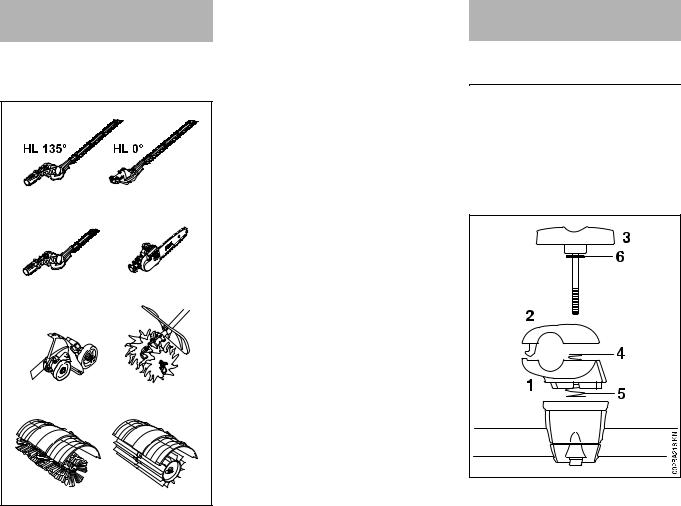
English
Approved Power Tool
Attachments
The following STIHL interchangeable attachments may be mounted on the basic machine:
FH |
HT |
FCS |
BF |
KB |
KW |
|
228BA047 KN |
Interchangeable |
|
attachment |
Use |
BF 1) |
Soil cultivator |
FCS 2) 3) |
Edger |
FH 1) |
Scrub cutter |
HL 0° 2) |
Hedge trimmer |
HL 135° 1) 2) |
Hedge trimmer |
HT 2) |
Pole pruner |
KB (4601) 2) |
Bristle brush |
KW (4601) 2) |
Sweeper drum |
|
assembly |
1)stop (barrier bar) on loop handle is required
2)not approved for machines with bicycle handle
3)harness need not be used
Mounting the Bike Handle
Attaching the bicycle handle with rotating handlebar support
The machine is delivered with the rotating handlebar support already attached to the shaft. The clamps must be removed in order to attach the handlebar.
Removing the clamps
Nhold onto the lower (1) and upper clamps (2)
NUnscrew the tommy screw (3) – after the tommy screw has been unscrewed, the parts are loose and are pressed apart by the two springs (4, 5)!
20 |
FS 110, FS 110 R |
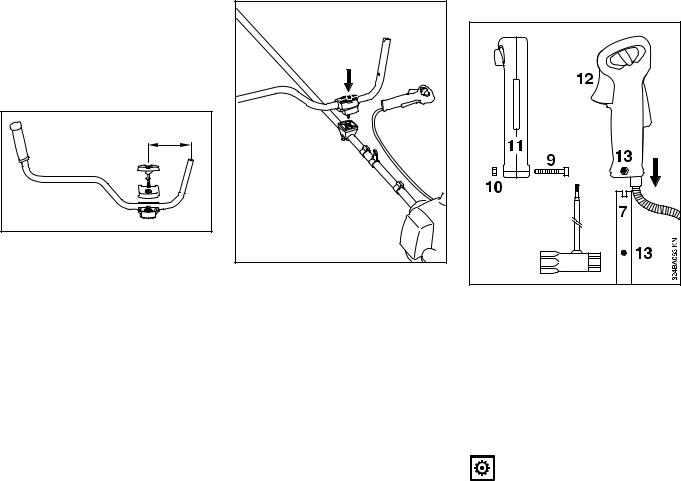
NRemove the tommy screw – washer (6) remains on the tommy screw
NSeparate clamps – springs (4, 5) remain in the lower clamp!
Fastening the handlebar
A |
|
7 |
|
1 |
250BA046 KN |
NPosition the handlebar (7) in the lower clamp (1) so that distance (A) is not more than 6 in. (15 cm)
NPlace the upper clamp on top and hold both clamps together
NInsert the tommy screw with the washeronitthroughbothclampsas far as it will go – hold all parts together and secure them
8 |
002BA234 KN |
NPosition the entire secured assembly on the handlebar support (8) with the tommy screw facing the motor
NPress the tommy screw into the handlebarsupportasfarasitwillgo and then screw it in – do not tighten it down yet
NAlign the handlebar so that it is perpendicular to the shaft – check distance (A)
N Tighten tommy screw
English
Attaching the control handle
NUnscrew the bolt (9) – the nut (10) remains in the control handle (11)
NPush the control handle with the throttle trigger (12) facing toward the gearbox onto the end of the handlebar (7) until the holes (13) align
N Screw in and tighten the bolt (9)
Fastening the throttle cable
Do not kink the throttle cable or run it in tight radiuses – the throttle trigger must move freely!
FS 110, FS 110 R |
21 |

English
 14
14
 15
15
14
15
250BA002 KN
NPress throttle cable (14) into the throttle cable support (15)
Adjusting the throttle cable
NCheck throttle cable adjustment – see "Adjusting the throttle cable"
Swiveling the handlebar
Into the transport position
NLoosen the tommy screw (3) and unscrew it until it is possible to swivel the handlebar (7) clockwise
NTurn the handle bar 90° and then swivel it downward
N Tighten tommy screw (3)
Into the working position
NSwivel and turn the handlebar counterclockwise in the opposite of the order described above
Mounting the Loop Handle
Mounting the Loop Handle with Barrier
Bar |
2 |
1 |
1 |
002BA098 KN |
NFit the square nuts (1) in the barrier bar (2); the holes must line up.
22 |
FS 110, FS 110 R |
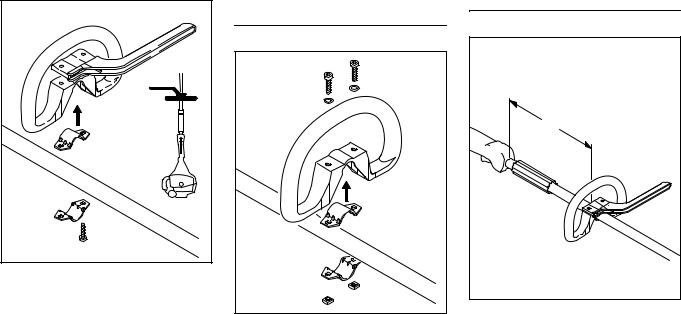
2
4
|
3 |
|
|
5 |
|
6 |
7 |
KN |
|
002BA099 |
|
|
|
NPlace the clamp (3) in the loop handle (4) and position them both against the drive tube (5).
NPlace the clamp (6) against the drive tube.
NPlace the barrier bar (2) in position as shown.
N Line up the holes.
NInsert the screws (7) and tighten them down moderately against the barrier bar.
N Go to "Securing the Loop Handle".
Mounting the Loop Handle without Barrier Bar
8 |
8 |
|
|
7 |
|
||
7 |
4 |
|
|
|
|
||
|
3 |
|
|
|
5 |
|
|
6 |
1 |
KN |
|
|
|||
1 |
002BA136 |
||
|
|||
|
|
NPlace the clamp (3) in the loop handle (4) and position them both against the drive tube (5).
NPlace the clamp (6) against the drive tube.
N Line up the holes.
NFit washers (7) on the screws (8) and insert the screws in the holes. Fit the square nuts (1) and screw them down as far as stop.
N Go to "Securing the Loop Handle".
English
Securing the Loop Handle
A |
9 |
4 |
10 |
002BA147 KN |
NSecure the loop handle (4) approx. 8 in (20 cm) (A) forward of the control handle (9).
N Line up the loop handle.
NTighten down the screws firmly – lock the nuts if necessary.
Thesleeve(10)(notfittedonallmodels) must be between the loop handle and the control handle.
FS 110, FS 110 R |
23 |
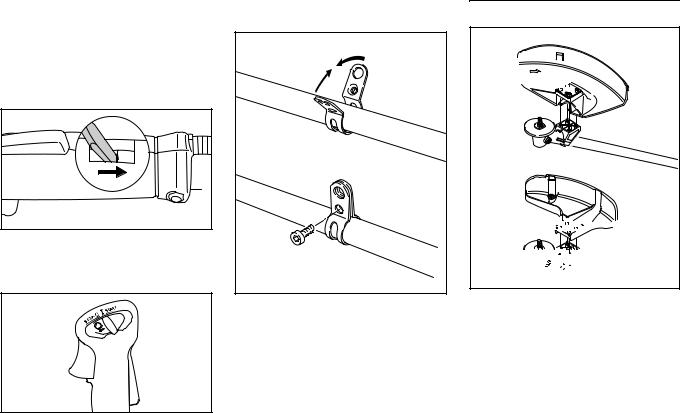
English
Adjusting the Throttle Cable |
|
Fitting the Carrying Ring |
|
Mounting the Deflector |
|
|
|
|
|
A properly adjusted throttle cable is the precondition for correct operation in the full throttle, starting throttle and idle positions.
Adjust the throttle cable only after the unit is fully assembled – the control handle must be in the normal operating position.
002BA163 KN
NUse a suitable tool to push the slide to the end of the slot (see illustration).
 STOP
STOP
2
|
KN |
1 |
249BA017 |
|
NPress down the throttle trigger lockout (1) and squeeze the throttle trigger (2) (full throttle) – this sets the throttle cable correctly.
The carrying ring comes standard with the machine or is available as a special accessory.
|
1 |
|
|
1 |
|
2 |
KN |
|
002BA142 |
||
|
For position of carrying ring see "Main Parts".
NPlace the clamp (1) against the drive tube with the tapped hole on the left (viewed from engine).
NSqueeze the two ends of the clamp together and hold in that position.
N Insert the M6x14 screw (2). N Line up the carrying ring.
N Tighten down the screw firmly.
Mounting the Deflector
1
3



2
3













 KN002BA380
KN002BA380
1 Deflector for mowing attachments
2Deflector for mowing heads
Deflectors (1) and (2) are both mounted to the gearbox in the same way.
NPlace the deflector on the gearbox flange.
NInsert the screws (3) and tighten them down firmly.
24 |
FS 110, FS 110 R |
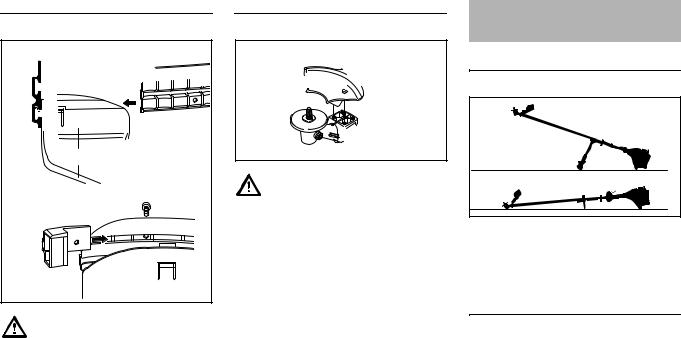
Fitting the Skirt and Blade
4 



4 


1
5
002BA103 KN
These parts must be fitted to the deflector (1) when you use a mowing head.
NSlidethelowerguideslotoftheskirt
(4) onto the deflector (1) – it must snap into position.
NPush the blade (5) into the upper guide slot on the skirt and line it up with the first hole.
NInsert the screw and tighten it down firmly.
Mounting the Limit Stop
7 6 





 002BA382 KN
002BA382 KN
Alwaysfitthelimitstop (6)whenyouuse a circular saw blade.
NPosition the limit stop (6) on the gearbox flange.
NInsert the screws (7) and tighten them down firmly.
English
Mounting the Cutting
Attachment
Preparations
002BA104 KN
NLay your brushcutter on its back so that the cutting attachment mounting face is facing up.
Mounting hardware for cutting attachments
The mounting hardware supplied depends on the cutting attachment that comes as original equipment with the new machine.
Mounting hardware is not packed with machine
Only mowing heads can be mounted.
FS 110, FS 110 R |
25 |
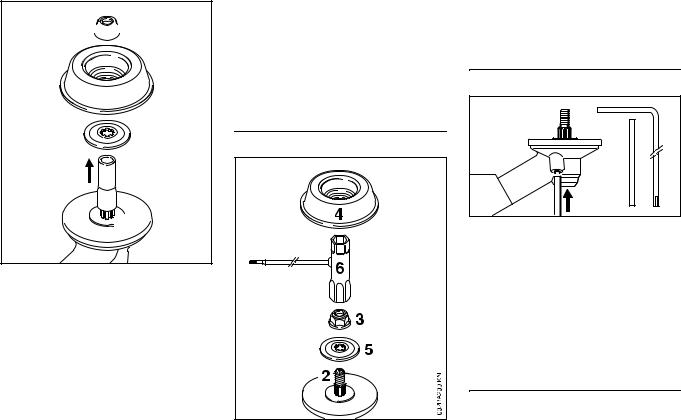
English


 3
3
4
|
5 |
1 |
|
2 |
KN |
|
002BA164 |
NPull the hose (1) (protector for shipping) off the shaft (2).
N Go to "Mounting the mowing head".
If you want to mount a metal cutting attachment in place of a mowing head, you will need the following additional parts: Nut (3), rider plate (4) and thrust washer (5) (special accessories).
Mounting hardware is packed with machine
Mowing heads and metal cutting attachments may be mounted.
If the parts are packed with the machine
NPull the hose (1) (protector for shipping) off the shaft (2).
The nut (3), rider plate (4) and thrust wsher (5) are in the parts kit supplied with the machine.
NGo to "Mounting the mowing head" or "Mounting the metal cutting attachment".
If the parts are mounted to the gearbox
NGo to "Removing the mounting hardware".
Removing the mounting hardware
NBlock the shaft – see next chapter on "Blocking the output shaft".
NUse the combination wrench (6) – comes standard with machine or is available as special accessory – to unscrew the nut (3) clockwise (lefthand thread) from the shaft (2).
NPull the thrust washer (5) off the shaft (2).
The rider plate (4) is in the parts kit supplied with the machine.
NGo to "Mounting the mowing head" or "Mounting the metal cutting attachment".
Blocking the output shaft
|
2 |
|
8 |
|
KN |
7 |
7 |
002BA166 |
|
|
NInsertthestoppin (7)orscrewdriver
–come standard with machine or areavailableasspecialaccessories
–inthehole (8)inthegearboxasfar as stop, and apply slight pressure.
NRotatethenutorcuttingattachment on the shaft (2) until the stop pin slips into position and blocks the shaft.
Attaching the mowing head
Keep the information sheet for the mowing head in a safe place.
26 |
FS 110, FS 110 R |
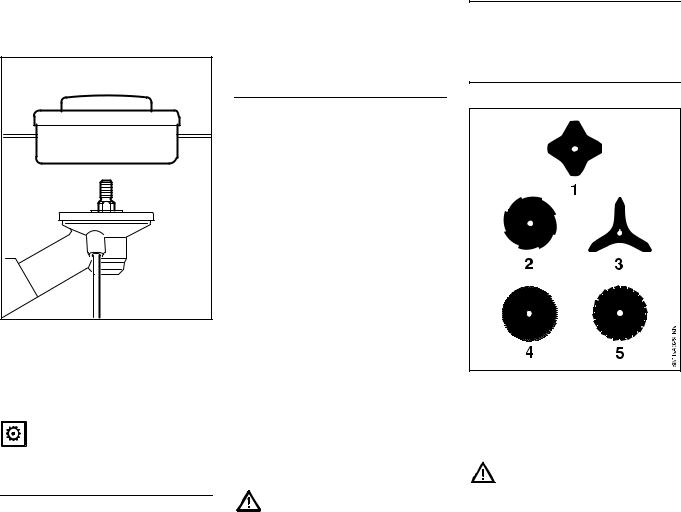
STIHL SuperCut 20-2, |
STIHL AutoCut 25-2, |
STIHL AutoCut C 25-2, |
STIHL TrimCut 31-2, STIHL FixCut 25- |
2, STIHL PolyCut 20-3 |
1 |
002BA081 KN |
NTurn the mowing head counterclockwise until it is flush against the shaft (1)
N Block the shaft
N Tighten the mowing head
Remove the tool used to block the shaft.
Removing the mowing head
N Block the shaft
STIHL SuperCut 20-2,
STIHL AutoCut 25-2,
STIHL AutoCut C 25-2,
STIHL TrimCut 31-2, STIHL FixCut 25- 2, STIHL PolyCut 20-3
N Turn the mowing head clockwise
Feed out mowing line
STIHL SuperCut
Line is fed out automatically if the mowing line is at least 2 1/2 in. (6 cm) long – the blade on the deflector shortens excessively long mowing line to optimum length.
STIHL AutoCut
NHold the mowing head parallel above the surface of the lawn – tap it on the ground – approx. 1 1/4 in. (3 cm) of mowing line is fed out
The blade on the deflector shortens excessively long mowing line to optimum length – thus repeated tapping in succession is to be avoided!
Mowing line is only fed out if both mowing lines are still at least 1 in. (2.5 cm) long!
For all other mowing lines
Proceed as described in the mowing head information sheet.
Always switch off the engine to fed out mowinglinebyhand–otherwisethereis a risk of injury!
English
Replacing mowing line and/or cutting blade
Proceed as described in the mowing head information sheet.
Mounting metal cutting attachments
The skirt and lne limiting blade are not required on the deflector for grass cuttingblades230-4 (1),230-8 (2)orthe brush knife (3) – see "Mounting the Deflector".
Fit the approriate limit stop for circular saw blades 200 (4, 5) – see "Mounting the deflector".
Layyourbrushcutteronitsbackwiththe cutting attachment mounting face pointingup:Thecuttingedgesof(1)and
FS 110, FS 110 R |
27 |
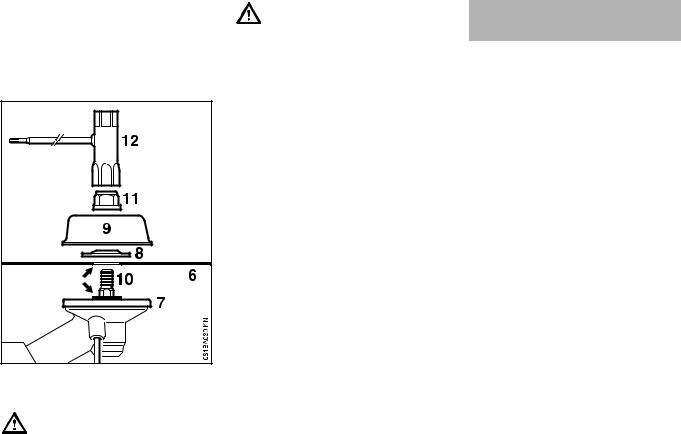
English
(3) may point in either direction. The cutting edges of (2), (4) and (5) must point clockwise.
Direction of rotation is indicated by an arrow on the inside of the mowing attachment deflector or limit stop.
NPlace the cutting attachment (6) on the thrust plate (7).
Collar (see arrow) must engage the mowing head's mounting hole.
NFit the thrust washer (8) and rider plate (9) on the shaft (10).
N Block the drive shaft.
NUsethecombinationwrench (12)to screw the mounting nut (11) on to the output shaft counterclockwise and tighten it down firmly.
If the mounting nut turns too freely, fit a new one.
Removing the metal cutting attachment
N Block the drive shaft.
NUnscrew the mounting nut clockwise.
NTake the parts off the shaft – do not remove the thrust plate (7).
4-MIX Engine
The STIHL 4-MIX engine features mixturelubrication and mustberun ona fuel mixture of gasoline and engine oil.
It operates otherwise on the 4-stroke principle.
28 |
FS 110, FS 110 R |
